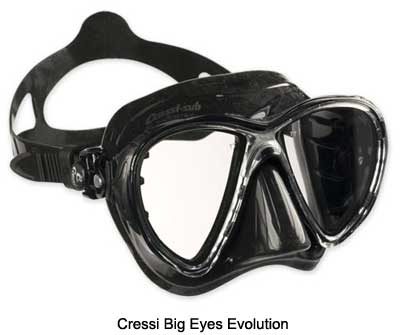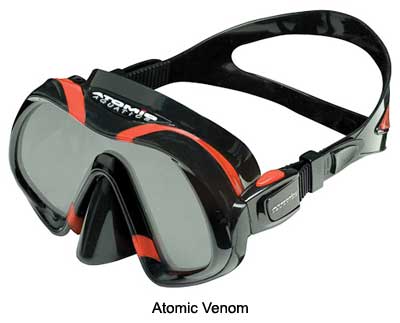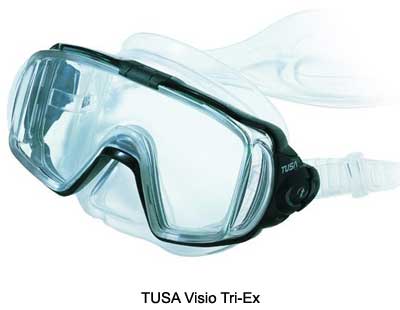Behind the MasksContents of this Issue: Mayan Princess, Roatan, Honduras Cancun, Cabo San Lucas, Fiji, Truk. . . Give Your Buddies a Free Undercurrent Subscription Improving Rebreather Safety: Part I Widow Blames Dive Gear for Death of Filmmaker Parents of Drowned Boy Sues PADI and Boy Scouts Editorial Office: Ben Davison Publisher and Editor Undercurrent 3020 Bridgeway, Suite 102 Sausalito, CA 94965 what to buy for your face shape, vision, even color preference from the August, 2012 issue of Undercurrent
When I pioneered equipment-comparison tests in the 1980s, there were a lot fewer choices for divers in the shops. Since then, we've had the consumer excesses of the noughties, and there are more brands in all categories to choose from, and more diving products bearing those brands. If you want to replace your mask, it can be rather confusing. Like shoes, a mask is a personal item, and there is no single example that will outshine the rest. No wonder experienced divers simply want to replace their favorite mask, when the time comes, with another that's exactly the same. Masks that are undamaged rarely leak, but faces often do! When you're in a shop, inhaling through the nose so that the mask will stick in place by air pressure alone, keep in mind that a perfect fit in the shop may not be so perfect once you bite down on your regulator mouthpiece and it alters the shape of your face. This is especially true for rebreather divers. Rebreather mouthpieces can need more of a firm grip, due to the weight of the hoses and peripheral displays that may be attached. Often, a new rebreather diver finds that a favorite mask mysteriously leaks water when it did not with open-circuit gear, and of course, clearing a leaking mask can be a problem for a closed-circuit diver. Color Makes a Difference Clear silicone skirts had a tendency to go yellow with time, but that is less true due to the latest silicone technology. Underwater photographers and technical divers prefer an opaque skirt, believing there are fewer internal reflections to disturb their view. I can guess that a lot of techies will go for the retro-look of the AquaLung Teknika ( $85 list price; www.aqualung.com ) Some masks employ expensive varieties of glass that has less color, and this can improve the clarity of the view. An extreme example is the singularly expensive Atomic Subframe ARC ($158), with its antireflective coating, or the equally costly sibling Atomic Venom ($199), which has a massive front of very clear Schott glass ( information for both masks is at www.atomicaquatics.com ). I wonder if it is necessary to pay the money asked for masks such as these.
On the other hand, underwater photographers tend to like their models to wear masks with clear silicone skirts so that their faces are better lit and there are fewer tendencies to look like the Lone Ranger, Zorro or some other masked Avenger. Mares offers its X-Vu ($82; www.mares.com ) with a curious, opaque brown silicone option, the IST Blue Tech ( $65; www.istsports.com ) can be supplied in camouflage colours, while some other manufacturers offer an attractive, translucent, frosted look. When it comes to the fabric of the skirts, the challenge is to make a silicone that is extremely soft and flexible, yet as hard-wearing as possible. Cressi uses a mix of silicones for its clear Crystal masks, while its fierce competitor, Mares, uses a material it calls Liquid Skin. Straps and buckles can be important. The buckles of the really expensive Atomic masks are a dream to use, but then, at the price asked, they should be. Many Oceanic masks eschew the more traditional silicone strap, and come with adjustable webbing and a neoprene pad for the back of the head. Twin-Lens Masks This seems to be the most popular group because they have a lower internal volume and, of course, it is possible to fit, where supplied, corrective lenses, or add corrective lenses to individual sides for those with less than perfect eyesight. However, while many manufacturers offer corrective options for short-sighted people in minus-strength diopres, fewer appear to offer the plus-strength range needed by those who are suffering the ravages of time. Long-sighted divers usually need to send their masks to specialist suppliers for adaptation.
[Many masks have adopted a teardrop shape to the lenses, with the aim of giving divers a better downward view of their chest area. Cressi pioneered this design with the lenses tilted forwards. Its Big Eyes Evolution is the most recent model, although Cressi also offers the smaller Eyes Evolution with the same feature ( $90; www.cressisubusa.com ). Masks like the AquaLung Favola $80; www.aqualung.com ) and Mares X-Vision ( $70; www.mares.com ) are similar, but without the tilt. Compact Twin-Lens Masks
Single Faceplate Masks Traditionally, divers thought that bigger faceplates meant a wider view. It doesn't always work like that. Thanks to the refraction of light as it passes through from water to the air inside the mask, there will always be a degree of tunnel vision underwater. That said, while some divers like very compact masks, others go for the wider view thought to be provided by a single faceplate. One of the biggest afforded is that of the Atomic Venom, which has expensive Schott glass that has no color ( $199, www.atomicaquatics.com ). Those who like the advanced Crystal silicone of Cressi will appreciate the much less expensive Piuma ( $89; www.cressisubusa.com ). The Seac Boss is of a traditionally heavyweight design ( $58; www.seacsub.com ), while the likes of the Oceanic Accent ( $80; www.oceanicworldwide.com ) and the Atomic Frameless ( $105; www.atomicaquatics.com ) have managed to do without too much intrusive structure. Masks in a Smaller Size Many mask manufacturers offer their products in a smaller size to accommodate smaller faces. These include the Beuchat X-Contact ( $68; www.beuchat-usa.com ), th e Atomic Frameless ( $105; www.atomicaquatics.com ) and the Oceanic Shadow ( $84; www.oceanicworldwide.com ) Multi-Lens Masks In an attempt to give divers a view of what might be beside them, whether it be their buddy, an intrusive bit of wreckage or a big animal, some masks have side windows. Some find such a mask a bit like sitting inside an conservatory, while others love them. Personally, I don't think these designs give a wider view, and their extra weight and volume can make them difficult to get a good seal on to the face. But it's your choice. A good example is the TUSA Visio Tri-Ex($74; www.tusadive.com ). Masks for Ear Protection, Easy Cleaning and Full Face Coverage Divers who suffer from ear troubles while diving will see the IST ProEar mask as a godsend ($100; www.istsports.com ). It encloses the ears and the nose within the same airspace (they're linked by tubes with oneway valves), so that the ears are kept dry in the same way and can also be cleared of water. The air space around the ears can reveal the underwater world to be a rather noisy place, but otherwise it really works.
There will always be masks that really are unique. Ocean Reef's full-face Neptune Space G is one of a range of full-face masks that includes a specially adapted regulator, which accounts for its cost ($1,093; oceanreefgroup.com). However, apart from the use of underwater communications now popular with underwater television presenters, the only real use for a full-face mask is for when diving in polluted waters. As leisure divers, should we be doing that? Another expensive mask is the Oceanic Datamask, which includes a computer with a head-up display within it ($1,110; oceanicworldwide.com). It's linked by radio-transmitter to the gas pressure remaining in the diver's tank. It appears at first glance to be the mask for the diver who has everything, but the computer uses an older algorithm, and the space it takes up places the front glass of the mask further from the eyes. The consequence of this is a narrowed field of view, like looking down a couple of tubes, and the added weight tends to pull down on the top seal of the mask, allowing an inflow of water. Sorry, Oceanic, it's a nice idea, but it doesn't do its primary function well. John Bantin is the technical editor of DIVER magazine in the United Kingdom. For 20 years, he has used and received virtually every piece of equipment available in the U.K. and the U.S., and makes around 300 dives per year for that purpose. He is also a professional underwater photographer. |

I want to get all the stories! Tell me how I can become an Undercurrent Online Member and get online access to all the articles of Undercurrent as well as thousands of first hand reports on dive operations world-wide
| Home | Online Members Area | My Account |
Login
|
Join
|
| Travel Index |
Dive Resort & Liveaboard Reviews
|
Featured Reports
|
Recent
Issues
|
Back Issues
|
|
Dive Gear
Index
|
Health/Safety Index
|
Environment & Misc.
Index
|
Seasonal Planner
|
Blogs
|
Free Articles
|
Book Picks
|
News
|
|
Special Offers
|
RSS
|
FAQ
|
About Us
|
Contact Us
|
Links
|
3020 Bridgeway, Ste 102, Sausalito, Ca 94965
All rights reserved.

 The Japanese manufacturer TUSA has historically met this demand with its Liberator range, which
offers both plus- and minus-strength lenses. Maybe it's because Japan has a famously aging population!
Otherwise, during my research, I discovered that only the Beuchat X-Contact from France, where diving
is known as the sport for grandparents, is available (at extra cost) with a wide
range of off-the shelf lenses in both plus and minus strengths ( $68;
The Japanese manufacturer TUSA has historically met this demand with its Liberator range, which
offers both plus- and minus-strength lenses. Maybe it's because Japan has a famously aging population!
Otherwise, during my research, I discovered that only the Beuchat X-Contact from France, where diving
is known as the sport for grandparents, is available (at extra cost) with a wide
range of off-the shelf lenses in both plus and minus strengths ( $68;  By making the lens area smaller and moving it closer to the eyes so that
the view is not impinged, manufacturers can offer masks with a much smaller
internal volume, which means easier clearing. These compact masks prove
very popular with breath-hold divers, but many scuba divers opt for this formula,
too. They are most commonly purchased with opaque skirts, but in my
experience, this option offers no particular advantage because the glass is so
close to the eyes. Good examples of this sort of mask include the Sherwood
Eclipse ( $65;
By making the lens area smaller and moving it closer to the eyes so that
the view is not impinged, manufacturers can offer masks with a much smaller
internal volume, which means easier clearing. These compact masks prove
very popular with breath-hold divers, but many scuba divers opt for this formula,
too. They are most commonly purchased with opaque skirts, but in my
experience, this option offers no particular advantage because the glass is so
close to the eyes. Good examples of this sort of mask include the Sherwood
Eclipse ( $65;  Clearing the mask is always a problem for new divers, and there are a
number of masks on the market that include an automatic purge valve in an
attempt to make things easier, but there's no substitute for being shown how to
do it properly. The IST Dynasty is a typical example that might help the hopeless
trainee ($55;
Clearing the mask is always a problem for new divers, and there are a
number of masks on the market that include an automatic purge valve in an
attempt to make things easier, but there's no substitute for being shown how to
do it properly. The IST Dynasty is a typical example that might help the hopeless
trainee ($55; 